Over 70% of hospitals now use predictive AI tools in billing and scheduling. There’s a good reason: most still rely on manual schedulers and endless phone calls to book appointments. Outdated systems and staffing shortages make it harder to keep patient flow steady and respond to care needs on time.
We get it. You want results, not another shiny toy. That’s why, at Aloa, we build AI systems for healthcare that integrate with the tools you already use. With our take on AI in healthcare administration, we help you start small, integrate cleanly, and scale safely.
Stick around, because we’ll cover:
- Smarter patient scheduling and resource use
- AI that actually helps in billing and revenue cycle
- Document automation that’s compliant and reliable
We’ll talk through practical moves that make tomorrow’s shift easier than today’s.
AI in Healthcare Administration
AI in healthcare administration takes on the tasks that eat up staff time: scheduling, claims edits, staffing, and patient questions. It reduces errors, uses predictive analytics to forecast demand, and keeps patient flow steady. You’ll see less admin stress, smarter use of resources, and more time for direct patient care.
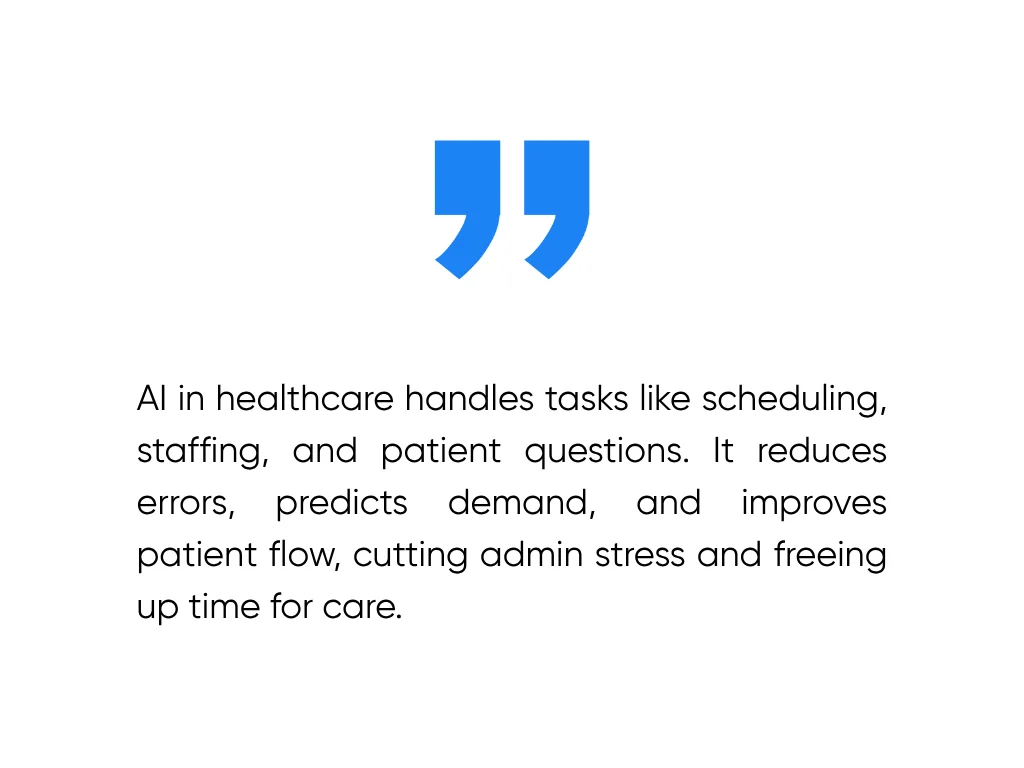
A “normal” day might look like this at a clinic:
- The front desk drowning in appointment scheduling calls.
- The billing team battling another stack of claim denials.
- Managers scrambling to plug a shift gap (again).
- Patients on hold forever just to confirm or move an appointment.
That’s where AI can help take the load:
- Patient Communication: Virtual health assistants handle routine questions before your phone lines melt down. UTSA researchers show how assistants already lean on AI for quick requests, chart updates, and record accuracy, which frees them up for the conversations that actually need a human.
- Scheduling Support: Prediction models flag likely no-shows so schedulers can refill the slot before it goes cold. Empty chairs turn into patients seen, and wasted hours turn productive.
- Billing Help: Claims automation catches errors in administrative processes and medical data before they leave the building. And cleaner claims mean fewer denials, faster turnaround, and less grunt work.
- Staffing Relief: Scheduling systems build rosters around demand patterns across healthcare facilities and units. Less last-minute scrambling for managers and schedules that feel fair for staff.
AI has the potential to alleviate pressure on your team. Start with the work that burns the most time (scheduling, billing, documentation), and that’s where you’ll see wins stack up fastest. For your reference, we pulled together a digest of 7 examples of AI in healthcare to show what’s already working in the field.
1. Better Patient Scheduling and Resource Allocation
If you run hospital ops, you know the chaos on a daily basis. AI won’t wave it away with a magic wand, but it can easily take some of the chaos because it’s what AI is best at.
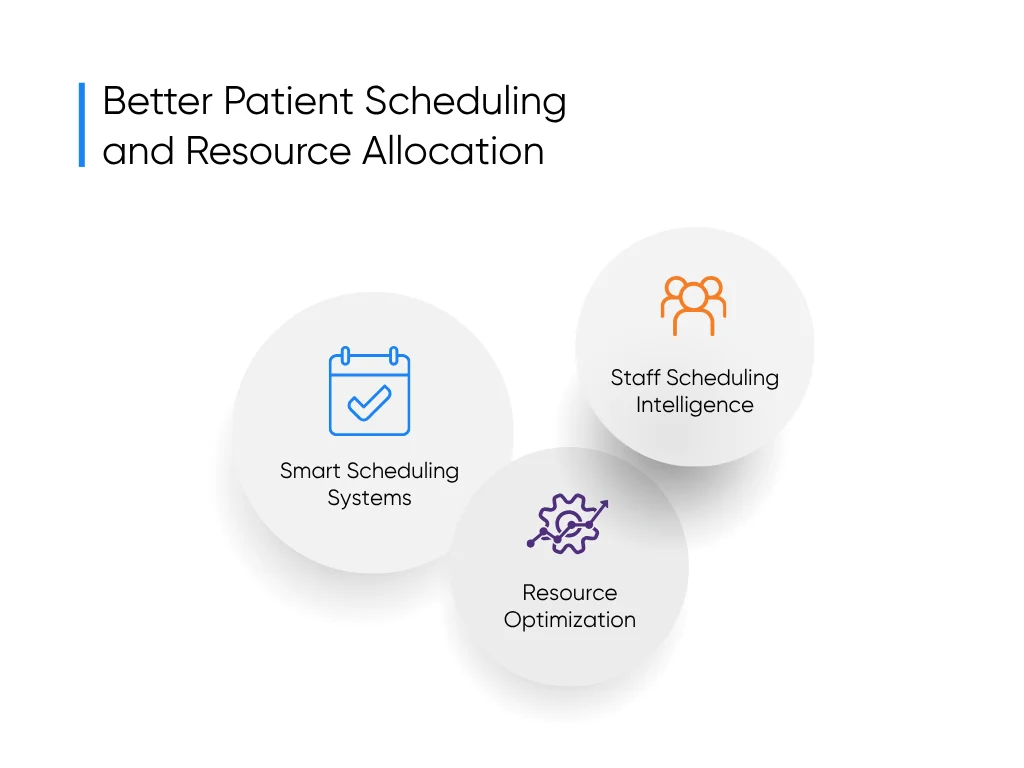
Smart Scheduling Systems
Smart scheduling uses AI to learn from your hospital’s scheduling history and spot the usual troublemakers: patients who always cancel, appointments that never end on time, and hours that somehow stay empty. Then it builds and adjusts schedules automatically to match what’s really happening day to day.
Here’s how smart scheduling keeps operations running smoother than your morning rounds:
- Predicts No-Shows: Flags patients likely to miss appointments so your team can double-book or send stronger reminders ahead of time.
- Automates Outreach: Sends personalized texts, emails, or calls to confirm or reschedule appointments before they’re missed or canceled.
- Optimizes Resources: Reassigns rooms, staff, or equipment instantly when cancellations or delays happen, keeping schedules tight and everyone’s time productive.
Tools like Qure4u and Zocdoc can plug into electronic health records on a subscription or per-appointment model. Hospitals using these platforms see fuller schedules, fewer no-shows, and quicker room turnover.
Resource Optimization
AI helps you optimize resources by tracking admissions, discharges, and procedure times, then aligning them with what’s happening in real time. It shows when beds, rooms, or equipment will be free and updates schedules automatically. Instead of manually checking every detail, you’re confirming that AI has already handled it. For context:
- Bed Forecasting: AI models predict demand with error margins as low as 0.5–4 percent. That accuracy means you can plan staffing and discharges with less guesswork.
- Keeping Machines Busy: Imaging and diagnostic departments use AI to smooth scanner schedules for medical imaging so images get read faster.
- Faster Bed Turnover: One healthcare system cut turnover times by 23 percent using predictive tools, unclogging ED bottlenecks and moving patients faster.
With AI managing resources, staff spend less time checking bed and equipment availability. Patients will move through each stage of care without unnecessary delays.
Staff Scheduling Intelligence
Staff scheduling is the toughest puzzle in hospital ops. Of course, AI won’t spit out the perfect roster every time, but it does take away the constant firefighting. It can learn from your volume, past shifts, seasonal swings, and population health patterns to line up coverage with demand. You’ll notice the difference in a few places:
- Volume-Based Shifts: AI spots surges and slowdowns before they hit and suggests coverage to match. You stop bouncing between too many hands on deck and not nearly enough.
- Automated Matching: Platforms like ShiftMed’s AI workforce suite run millions of shift matches. They weigh demand patterns against availability, preferences, and compliance rules so you don’t spend your nights arguing with Excel.
- Fewer Surprises: Hospitals using AI scheduling tools see steadier rosters and fewer last-minute changes. Staff get schedules that feel fair, which keeps turnover down and patient satisfaction up.
Some managers will say, “I’ve been building schedules for years. I know this game.” And they do. Experience matters. What AI brings is backup. It crunches every swap, no-show, and surge you’ve lived through and gives you foresight instead of guesswork. You’re still the one calling the shots, just without the midnight edits, the frantic texts, and the constant risk of burning people out.
2. Automating Revenue Cycle Management Through AI
If hospital ops were a house, poor revenue cycle would be the leaky roof. It’s whenever your claims bounce, collections stall, and your team spends hours chasing denials that never seem to end. Every leak means rework, phone calls, and money sitting in limbo while AR days climb. It’s the kind of grind that leaves staff drained as well. AI can patch the leaks that matter:
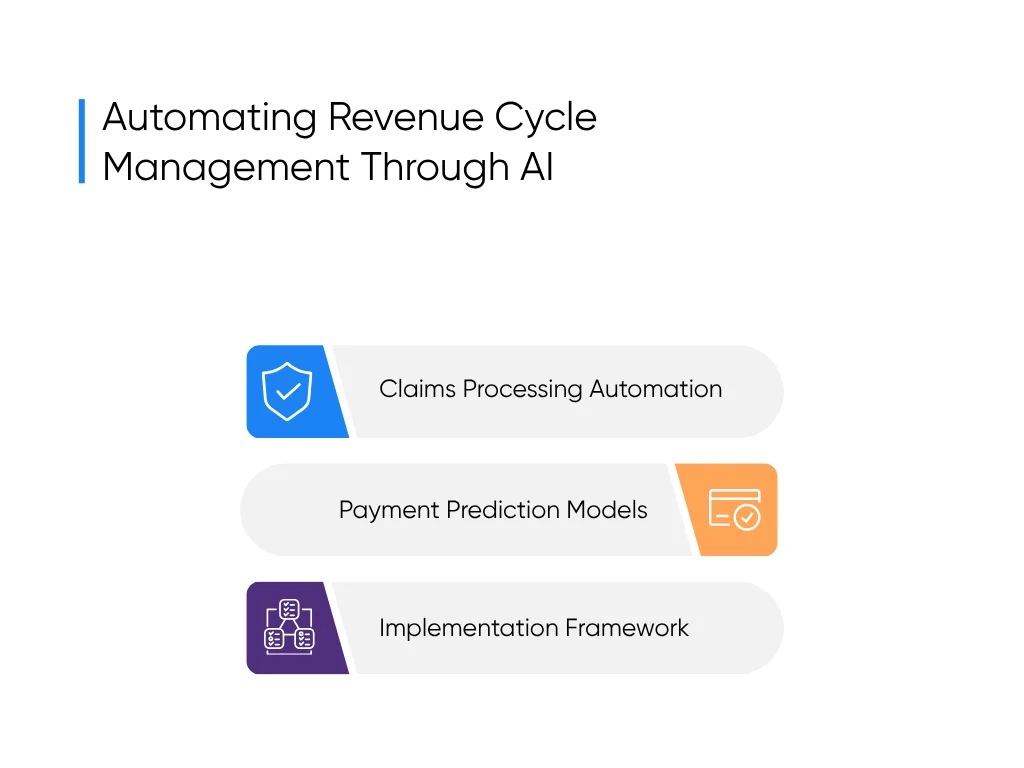
Claims Processing Automation
For claim processing, machine learning can spot the patterns in past denials before they repeat. Natural language processing makes sense of messy provider notes and ties them to the right codes in health records. Rule engines run payer logic up front so you’re not blindsided later.
Ask anyone running billing, and they’ll point to results like these:
- Medium-sized hospitals see 20–30% fewer denials with AI scrubbers; some specialty setups push closer to 85%.
- Reviews that used to eat 20 minutes now run in seconds, so staff finally work on the tricky claims that actually need them.
- Omega Healthcare scaled AI across 100 million+ claims, saved 15,000 hours a month, halved turnaround time, and still hit 99.5% accuracy.
That’s cleaner claims, faster checks, lower healthcare costs, and fewer delays for healthcare providers like you.
Payment Prediction Models
Payment prediction uses AI to forecast which claims or patient accounts will be paid, when payments will land, and which ones are likely to stall. It analyzes payer habits, balances, timelines, and past outcomes so your team can focus on accounts that recover revenue instead of chasing those that don’t.
You’ll see results similar to the following:
- The Deep Claim model boosted denial-prediction recall by ~22% at 95% precision.
- Hospitals using payment prediction report 10–15% jumps in collections, because staff spend time on accounts that actually pay.
- Teams segment AR better, focus staff time where recovery is real, and waste less effort chasing long shots.
Collections never get painless, but AI stops you from throwing good time after bad. And that steadies the cash flow while easing the grind.
Implementation Framework
Now, how do you roll this out without wrecking your workflow? You phase it in:
- Spot your biggest leaks: Go after the denials, AR days, or collections that sting the most.
- Pick the right vendor: Prioritize clean integration of AI with EHRs, real payer logic, airtight compliance, and pricing you can explain without a lawyer.
- Pilot smartly: Test AI side-by-side with your current process, and track denial reduction, AR days, and hours saved.
- Train your team: Show healthcare professionals that AI supports human expertise and clinical judgment. They stay in control.
- Track ROI: Simple math: fewer denials × average claim value + staff hours saved − software costs. Most hospitals see payback inside 12–18 months.
And partner with help like Aloa. We fold AI into the billing systems you already use, build connectors that fit your workflows, and tune the models so your revenue team stays in charge. That way, AI gets to be the patch that stops the leaks and steadies the cash flow. If you want a bigger picture, we also put together a no-fluff guide on AI in medicine that shows what smart implementation really looks like.
3. Improved Documentation and Data Management
Let’s be honest, nobody got into healthcare for the paperwork. Yet here we are: notes stack up, the same data gets typed twice, and by the end of a shift, the glow of the monitor has drained more energy than the patient rounds. AI can make it bearable by automating tasks, cleaning up records, and keeping data safe.
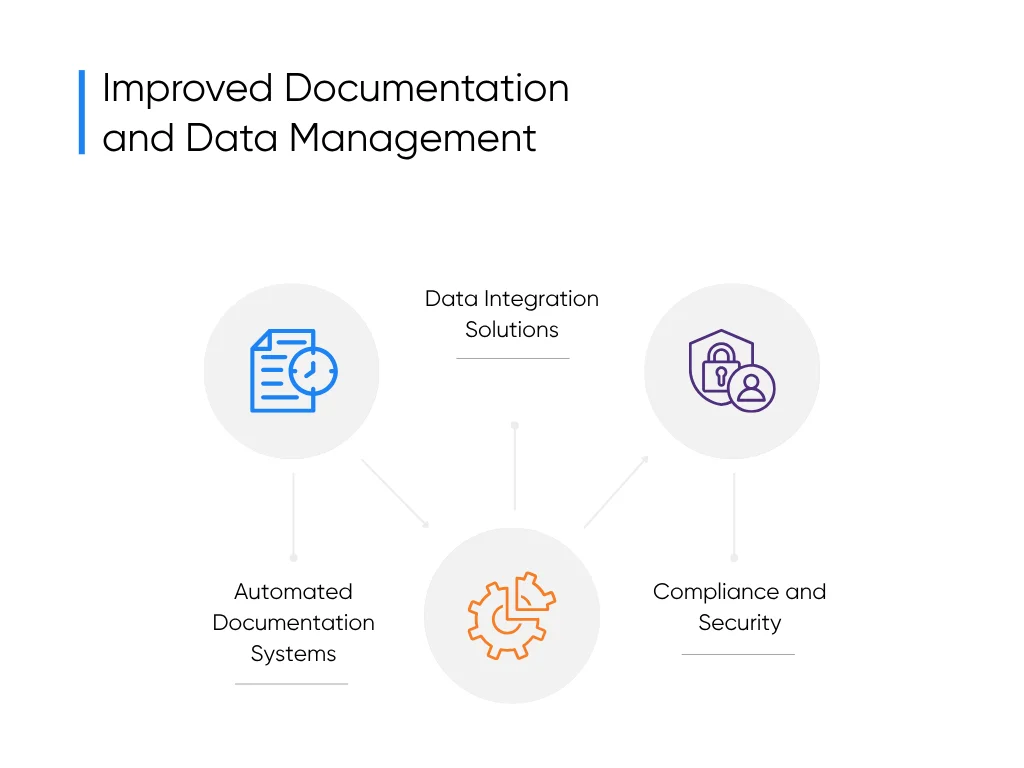
Automated Documentation Systems
Think of this as giving your staff a digital scribe. Natural language tools take speech, dictation, or messy notes and turn them into structured entries in the EHR and medical records. Staff skim, sign off, and move on.
The main pieces in action:
- Speech-to-Text: Dictation flows straight into charts and treatment plans, not a Word doc sitting on someone’s desktop.
- Named Entity Recognition: Pulls out meds, dates, and medical history details from free text and drops them in the right fields.
- Contextual Models: Read shorthand and acronyms using deep learning for more accurate diagnosis support.
- Auto-Coding Engines: Suggest ICD-10 or CPT codes, cutting the errors that send claims back.
And you feel it where it matters: charts done quicker, fewer denials, less paperwork hanging over staff at night. Aloa even built an AI medical transcription app if you’d like to see how the transcription engine works.
Data Integration Solutions
Hospitals operate through a tangle of systems (labs, imaging, billing, scheduling), and too often those systems hang in isolation. That leads to duplicate entries, mismatched patient IDs, and data siloes hurting workflow.
AI and data analysis stitch the mess into one flow across health systems and departments:
- Entity resolution and probabilistic matching reconcile records even when names or addresses don’t line up. That’s often used in Master Patient Index (MPI) or EMPI systems.
- Smart EHR integration/middleware translates legacy systems into modern formats, aligns patient records, and improves information flow.
- Data cleansing and normalization modules spot duplicates, fix missing fields, and smooth out inconsistencies.
- Real-time integration monitoring flags broken connections or latency before workflows crash.
Hospitals running these tools cut duplicate patient records by nearly a third and move patient information across teams faster.
Compliance and Security
Here’s the non-negotiable part: Artificial intelligence in healthcare administration has to be safe. Every system touching patient data must play by HIPAA rules. One hole in the fence, and you’re looking at fines, lawsuits, and lost trust.
AI platforms keep things tight by:
- Encrypting health data in storage and in motion.
- Locking access so only the right staff can view it.
- Logging activity so you always know who did what.
- De-identifying records before models ever train on them.
Handled right, data privacy and data security safeguards speed up work and keep trust intact. Staff ditch manual privacy checks, and leadership breathes easier knowing data sharing won’t backfire. Aloa breaks down How to Make Any AI Model Safe through HIPAA Compliance if you’re wondering how to keep AI safe in your own workflows.
Benefits of Using AI in Healthcare Administration
Nobody brings in AI for bragging rights. You bring it in because the paperwork never ends, errors keep slipping through, and cash flow crawls uphill. Put AI on the admin side and it chips away where the strain is sharpest:
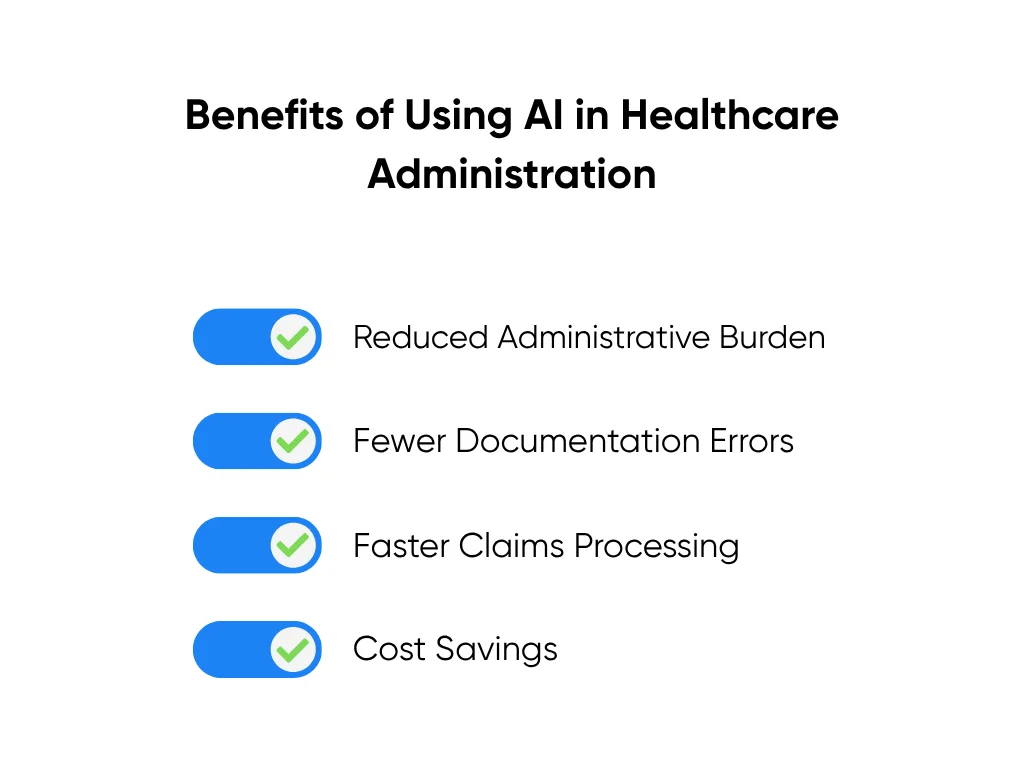
- Reduced Administrative Burden: AI applications take the retyping, routine tasks, reminders, and charting off healthcare professionals. Instead of burning hours on screens, they put that time back into patient flow and problem-solving.
- Reduced Human Error in Documentation: Missed fields and typos don’t just annoy; they trigger denials. NLP tools flag gaps, map shorthand to proper codes, and clean up messy notes before they ever hit billing.
- Faster Claims Processing: Claims get through the first time when AI scrubs them against payer rules. That means shorter turnaround, steadier reimbursements, and finance not holding its breath every cycle.
- Cost Savings: Fewer denials, less overtime, faster collections. Hospitals see measurable drops in admin spend and revenue that lands when it should.
AI isn’t here to replace staff. It’s here to pull the grunt work off their desk so judgment, care, and actual patient focus win some of that time back. The benefits of AI extend beyond admin. We put together a guide on how AI is transforming healthcare operations.
Challenges of Incorporating Healthcare AI
AI can take the edge off admin work, but rolling it out isn’t push-button simple. Hospitals run into the same snags over and over:
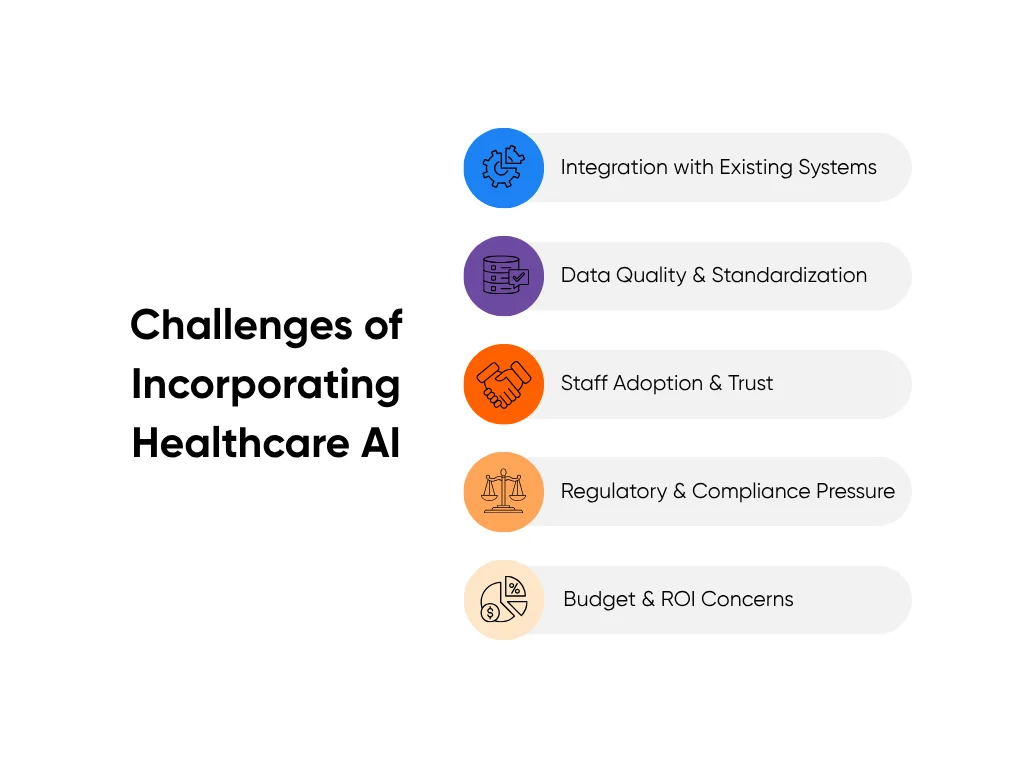
- Integration with Existing Systems: Every hospital runs on a Frankenstack of EHRs, billing software, and scheduling tools. If AI can’t plug into that mess, staff end up re-typing data instead of saving time.
- Data Quality and Standardization: AI only works as well as the data it gets. And hospital data? Often messy. Duplicate charts, missing info, inconsistent formats; it’s enough to throw any model off.
- Staff Adoption and Trust: If AI feels like more clicks or Big Brother, adoption tanks. In pilots, trust only grows once staff see it cut denials and paperwork while leaving final calls in their hands.
- Regulatory and Compliance Pressure: HIPAA isn’t negotiable. AI has to encrypt data, limit access, and log every touch. Skip those safeguards and compliance officers will shut it down before it starts.
- Budget and ROI Concerns: Leaders need proof inside a year: fewer denials, less overtime, faster reimbursement. If the numbers don’t show, projects stall.
Hospitals that make AI stick don’t go big right away. They start with one pain point (like denials or scheduling), prove it works, and then expand. That’s how you win over staff, keep compliance on side, and actually see a return.
Key Takeaways
AI is particularly effective at automating administrative tasks. If you can implement AI correctly for your own situation, the return shows up when fewer people are staying late just to catch up.
If you’re curious where to start, come talk to us. Tell us the one problem that eats your week, in clinical practice or admin, and we’ll tackle it. Not ready yet? Lurk in our Discord community or get bite-sized wins in your inbox with our AI newsletter.
Because in the end, AI in healthcare administration should make hospitals run smoother, not your staff run later.
FAQs
1. What are the primary benefits of implementing AI in healthcare administration?
AI cuts the grind. Hospitals see 30–50% drops in admin labor, 40–60% faster turnaround on routine work, and 15–25% better resource use. On the revenue side: fewer claim denials, fuller schedules, stronger collections. On quality: cleaner documentation, tighter compliance, shorter waits. Done right, projects hit 200–400% ROI in two years.
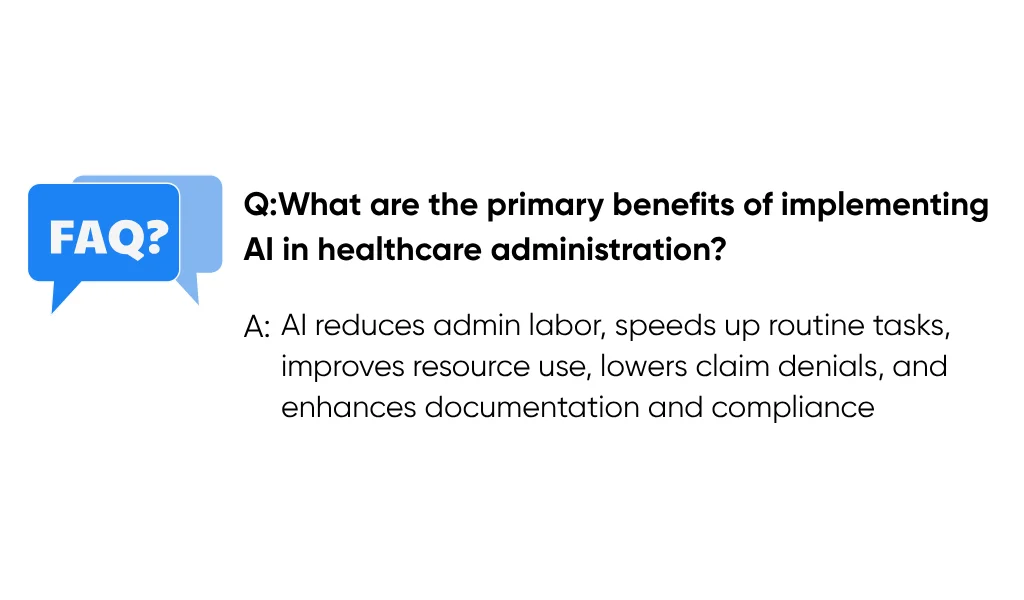
2. What are the biggest challenges healthcare organizations face when implementing administrative AI?
Plugging AI into old, clunky systems is a pain. Add messy data, skeptical staff, HIPAA hurdles, and vendors who talk big but don’t know healthcare. Then there’s budget: no clear ROI, no green light. Success takes planning, patience, and real change management.
3. How can healthcare organizations overcome staff resistance to AI implementation?
Be straight. Tell staff AI is here to ditch routine work, not jobs. Involve them in picking and testing tools. Train them properly. Start with willing departments, rack up quick wins, and let those stories spread. Internal champions beat consultant slides every time.
4. What criteria should healthcare organizations use to evaluate AI partners and vendors?
Pick folks who actually know healthcare delivery. They should speak HIPAA and FDA, have real case studies, and prove they can integrate with your EHR. Security, project management, and transparent pricing matter too. No outcomes? Walk away.
5. Should healthcare organizations build AI capabilities in-house or partner with external firms?
Usually, it’s a mix. External partners bring expertise and speed. Internal teams handle strategy, governance, and long-term fit. Smaller hospitals lean on partners; bigger systems often build AI teams too. The “right” setup depends on your size, budget, and goals.

